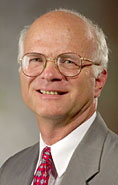OK, I’m fully expecting to receive some flak about this post, but I’m going to write it anyway.
I remember a scene in the movie Jurassic Park where, after hearing the scientific explanation about how the dinosaurs were cloned and brought to life, Dr. Ian Malcolm (played by rakishly nerdy Jeff Goldblum) says something like, “Just because you can do a thing, doesn’t mean you should do it.”
You know, technology is a lot like that. Just look at nuclear fission. The same technology that could give us almost unlimited, inexpensive electrical power, can also be turned on us in the form of nuclear weapons. Perhaps more to the point, it can also give us Three Mile Island and Chernobyl.
I apply that same sort of caution to an otherwise laudable effort by Dr. Dennis Hong and his team to develop technology that would allow blind people to drive a car. You can read more about it here and here. Dennis’ team is stepping up to the National Federation for the Blind‘s “Blind Driver Challenge“, sponsored by the Jernigan Institute.
I know. That was my reaction at first, also. Why in the world would we want blind people driving automobiles? Sighted people have enough trouble.
So, now that I have that out of my system, let’s talk about reality. There is no doubt that Hong’s engineering team will come up with some amazing ways to augment automobile navigation and control. But let’s face it, who will insure a blind driver? See, (no pun intended), driving is one of those personal responsibility things. If you hit somebody, it’s your fault. Period. The statistical tables are well understood for the insurance industry, which allows them to set rates based on likelihood of an accident for various population classes who drive.
Oh, and in case you didn’t know, the highest incidence of accidents is not reckless teenage boys with fast cars, as popular 1960s songs might lead you to believe. Nope, it’s teenage GIRLS. Not really a surprise, I suppose, is it?
Anyway, just imagine that Hong, or somebody, develops the technology to allow blind people to drive a car on the highway with everybody else. And suppose some critical part of that technology fails, as technology is wont to do at the most inopportune moments. And suppose this failure leads to an accident where, unfortunately, one or more people are killed. Maybe even the blind person.
The lawyers will have a field day. The blind driver’s family will sue the automaker and the people who developed the blind driving technology for misleading the blind driver into thinking it was safe to drive. The families of anybody else involved in the accident will sue the blind driver, and probably all the people the blind driver sues as well. Somebody will sue the regulatory agency that approved this fiasco. Who knows where it might end?
Which is why I don’t think this technology will ever be used to enable blind people to driver cars on the highway.
BUT, it could have other purposes. What would a foolproof blind driver system look like? Well, it would navigate for you, locate obstacles for you, predict paths for you to avoid objects, and pretty much just take over the driving for you.
In fact, if such as system could work, we would all end up in a world where none of us would actually be driving our cars at all. I mean, if it is that safe, then there would be a massive computer controlled road network with smart cars, no traffic jams, and pretty much no autonomy.
Might as well take a bus or a train….
So, what’s the end of this story? Well, I think Hong’s work will actually lead to systems that make cars safer and more convenient for sighted drivers, not blind ones. And while I completely sympathize with blind people and their limited autonomy in life, the usefulness of this technology to them will be limited to in-community, limited use roads such as within a retirement area. And maybe that is enough.
Be sure to spend a few minutes browsing Hong’s research lab website, the ROMELA lab. It’s full of very interesting and very, very creepy robotic things, including graduate students.
Hehe, just kidding. The graduate students, while creepy like all graduate students, are not, in fact, robotic as far as I know.
But with Dennis, you can never be sure….








